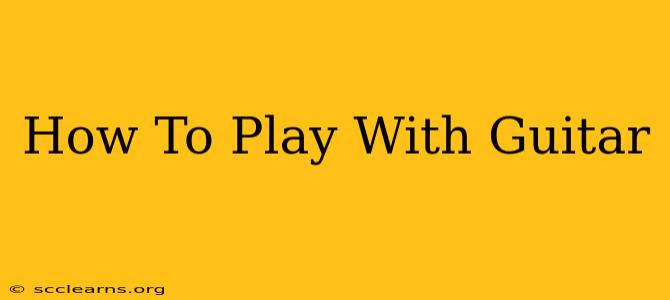So, you've got a guitar and you're ready to learn how to play? Fantastic! Learning guitar can be incredibly rewarding, a journey filled with musical expression and self-discovery. This guide will walk you through the fundamental steps, helping you navigate your first chords, strumming patterns, and essential techniques.
Getting Started: Essential Gear and Setup
Before you dive into playing, ensure you have the right tools:
- A Guitar: Acoustic or electric? The choice depends on your preference and musical style. Acoustic guitars are great for beginners due to their simpler setup. Electric guitars require an amplifier.
- A Guitar Pick (Plecrum): Experiment with different thicknesses to find what feels comfortable in your hand.
- A Tuner: Crucial for ensuring your guitar is in tune. There are clip-on tuners, smartphone apps, and even online tuners.
- A Comfortable Chair or Strap: Proper posture is important to avoid strain.
Learning Your First Chords: The Foundation of Guitar Playing
Mastering basic chords is the cornerstone of guitar playing. We’ll start with three essential, easy-to-learn chords: G major, C major, and D major.
1. G Major Chord:
This chord is formed by placing your fingers on the following frets:
- Second finger: on the 3rd fret of the high E string
- First finger: on the 2nd fret of the A string
- Third finger: on the 3rd fret of the high E string
2. C Major Chord:
The C major chord uses these finger positions:
- First finger: on the 1st fret of the A string
- Second finger: on the 2nd fret of the D string
- Third finger: on the 3rd fret of the G string
3. D Major Chord:
This chord involves:
- First finger: on the 2nd fret of the B string
- Second finger: on the 3rd fret of the G string
- Third finger: on the 2nd fret of the A string
Practice Tip: Start slowly. Focus on clean, clear notes before increasing your speed. Use a mirror to check your finger placement.
Strumming Patterns: Bringing Your Chords to Life
Once you've mastered these chords, it's time to learn some basic strumming patterns. Start with a simple down-down-up-down-up rhythm. Experiment with different rhythms and tempos as you become more comfortable.
Beyond the Basics: Expanding Your Guitar Skills
After mastering the initial chords and strumming patterns, explore these areas:
- More Chords: Learn other essential chords such as E major, A major, and Em (E minor). There are countless chords to discover, each opening up new musical possibilities.
- Finger Exercises: Regular finger exercises will strengthen your fingers and improve dexterity.
- Scales: Learning scales will expand your musical knowledge and enable you to improvise melodies.
- Music Theory: Understanding music theory will significantly improve your understanding and playing ability.
Resources for Learning Guitar
There are numerous resources available to help you on your guitar journey:
- Online Courses: Many online platforms offer structured guitar lessons for all skill levels.
- Guitar Teachers: A skilled teacher can provide personalized guidance and feedback.
- YouTube Tutorials: YouTube is a treasure trove of guitar tutorials covering everything from beginner basics to advanced techniques.
Conclusion: Embrace the Journey
Learning to play the guitar takes time and dedication. Don't get discouraged if you don't see results immediately. Practice consistently, be patient with yourself, and most importantly, enjoy the process. The satisfaction of playing your favorite songs will make the effort worthwhile. Happy strumming!

